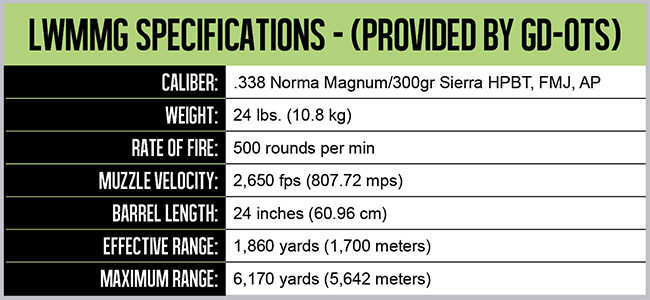ABOVE: Weighing 24 lbs., the GD-OTS Light Weight Medium Machine Gun is a full 5.5 lbs. lighter than the M240B, while the .338NM round has twice the velocity of the NATO standard 7.62 ball round.
GD-OTS .338NM Lightweight Medium Machine Gun doubles standard issue M240B in range and hitting power
Vast, open distances encountered by U.S. military combat troops in Afghanistan, when engaged by hostile forces situated on higher ground, illustrated a gap in squad-level machine gun capability. General Dynamics Ordnance and Tactical Systems (GD-OTS) of Vermont hopes to bridge this gap with its Lightweight Medium Machine Gun (LWMMG) offering that was on display at Modern Day Marine, 2014.

Developing a weapon with comparable ergonomic handling, portability, size and weight, yet twice the range of the standard M240B machine gun, GD-OTS has seized on a capability gap U.S. forces have experienced in the field. Foot mobile operations restrict weapons to those carried and deployed by individuals, without the additional personnel burden of assistant gunners. Deploying M2 .50 caliber machine guns is unrealistic without mechanized transport. U.S. infantry portable squad machine guns remain at the 7.62 NATO caliber level.
GD-OTS offers its .338NM (Norma Magnum) cartridge firing LWMMG as a bridge between the range and capability of the NATO 7.62 and .50 caliber rounds; one effective against body armor and lightly armored targets out to 1,000 meters. In addition, the weapon is highly effective in the anti-material role, and particularly against slow flying aircraft such as helicopters, due to the .338NM round’s flat trajectory, speed, range and destructive force, well in excess of the M-240B machine gun. While at a comparable weight of 24 lbs, a full 5.5 lbs. less than M240B, the .338NM round’s velocity is twice that of NATO’s standard 7.62 ball round.
Field reports indicate the GD-OTS LWMMG is highly accurate. Aided by the gun’s mitigation system, feel and perceived recoil are reported to be very similar to the current U.S. military issue M240B belt fed machine gun.

The LWMMG has a quick-change barrel with fixed headspace and timing. Integrated Mil-Std 1913 rails facilitate quick installation of a variety of optics and laser attachments. Ideal for maintenance in harsh field conditions, the LWMMG is field stripped down to six functional groups and no special tools are needed for field-level maintenance.
GD-OTS reports substantial interest in the LWMMG concept within the U.S. military, yet admit the reduced funding situation has delayed system acquisition.
Next Generation Fire Control System (FCS) Ready for Integration
GD-OTS showed off its internally funded Crew Served Weapons Fire Control System (FCS) at the 2014 Modern Day Marine Expo. Displayed clipped to a Mk47 crew served 40mm grenade launcher, the FCS displayed is not yet formally adapted for U.S. military use.
The type has been tested by armed forces end users and suggestions for improvements have been implemented. Users demanded day and night capability, including thermal and infrared. Ability to zoom in closely was also a major request, the GD-OTS team mentioned.

Sources at the Expo revealed special operators regard the FCS sight as much an asset as a weapon. The FCS may be used with a Mk47 and Mk19 40mm grenade launchers, M2/M2A1 .50 caliber machine guns are also supported.
Prior to firing an attached weapon, atmospheric conditions are calculated and applied to deliver the most accurate ballistic firing solution possible. Information is presented to the gunner on the FCS video display interface mounted just above the leaf sight on a Mk47 grenade launcher. The FCS provides color and night thermal imaging sighting using 17mm 640 x 512, 30 Hz thermal imager. Targeting is aided by an ANSI Z136.1 Class 1M laser rangefinder. The FCS will hold a target without drift, even as the weapon itself is super elevated; the gunner’s vision is not obscured.
FCS consists of six ruggedized key subsystems, video display, ballistics processor, day optics, night optics, and laser range finder and power system.










